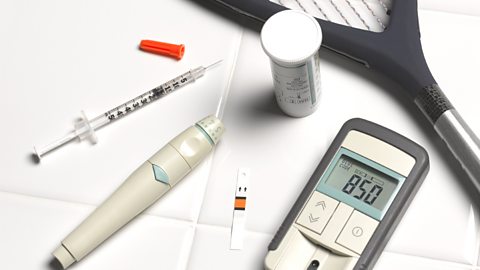Type 1 and Type 2 diabetes
Diabetes
Greg Foot explains the difference between Type 1 and Type 2 diabetes and the role insulin plays in controlling glucose levels
diabetesA serious disease in which the body is unable to regulate blood sugar. is a condition where the blood glucoseA simple sugar used by cells for respiration. levels remain too high. It can be treated by injecting insulinA hormone that regulates the level of sugar in the blood and can be produced by genetically modified bacteria.. The extra insulin causes the liver to convert glucose into glycogenAnimals store glucose as glycogen in their liver and muscle tissues., which reduces the blood glucose level.
There are two types of diabetes - Type 1 and Type 2.
Type 1 diabetes
Type 1 diabetes is a disorder in which the pancreas fails to produce enough insulin. This can be detected from an early age. It is characterised by uncontrolled high blood glucose levels and it can be controlled by injecting insulin.

People with Type 1 diabetes have to monitor their blood sugar levels throughout the day. Their levels of physical activity and their dietThe type and amount of food consumed by people. affect the amount of insulin needed.
They can help to control their blood glucose level by being careful with their diet, and eat foods that will not cause large increases in blood sugar level, and by exercising, which can lower blood glucose levels due to increased respirationThe chemical change that takes place inside living cells, which uses glucose and oxygen to release the energy that organisms need to live. Carbon dioxide is a by-product of respiration. in the muscles.
Type 2 diabetes
In Type 2 diabetes the person's body cells no longer respond to insulin produced by the pancreas. It is more common in older people. It can be controlled by a carbohydrateFood belonging to the food group consisting of sugars, starch and cellulose. Carbohydrates are vital for energy in humans and are stored as fat if eaten in excess. In plants, carbohydrates are important for photosynthesis. controlled diet and an exercise regime. Carbohydrate is digested into glucose, which raises the overall blood glucose level. There is a correlation between rising levels of obesityThe medical term for being very overweight, owing to the excessive accumulation of body fat. in the general population and increasing levels of Type 2 diabetes.
Question
Describe the pattern in this data. [5 marks]
The graph shows a range of data from 1990 to 2000. Mean body weight has steadily increased from approximately 72.5 kg in 1990, to 75.5 kg in 1997 up to just over 77 kg in 2000. [2 marks]
This matches a general increase in the number of people with Type 2 diabetes from 1990 to 2000. For example, the percentage was just below 5% in 1990 up to just below 7.5% in 2000. This shows an overall increase in 2.5% over 10 years. [2 marks]
There are dips and minor peaks within the graph, and these may be due to the introduction of a particular type of food, or other additional factors such as lifestyle. [1 mark]
Tips: use the labels on the axes to help you describe the relationship between the data in the graphs.